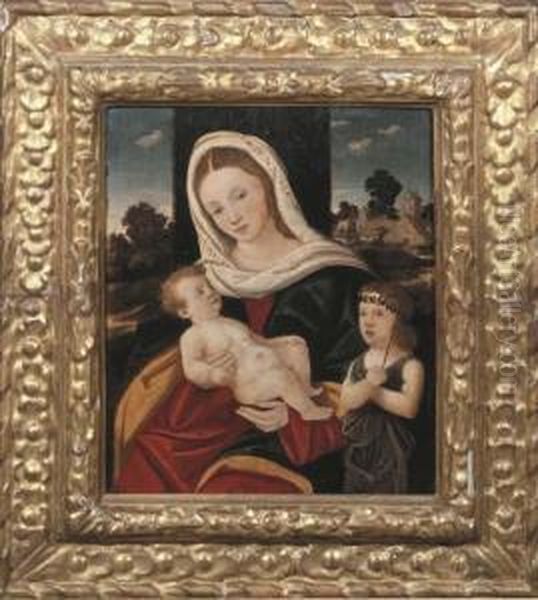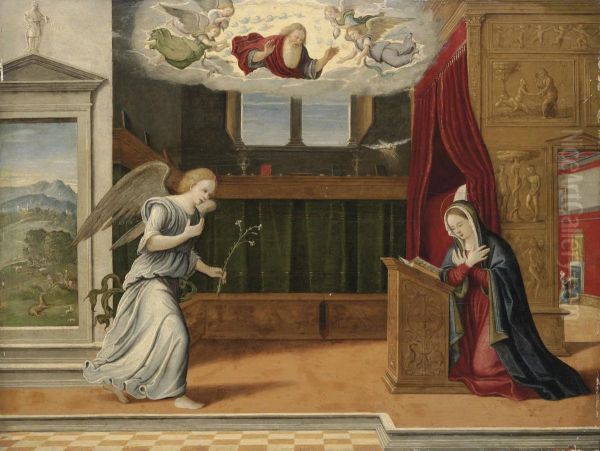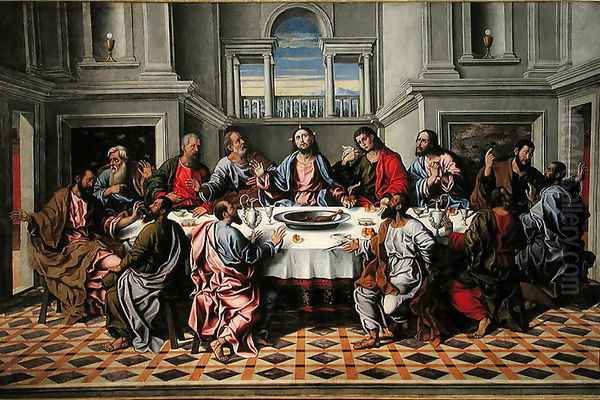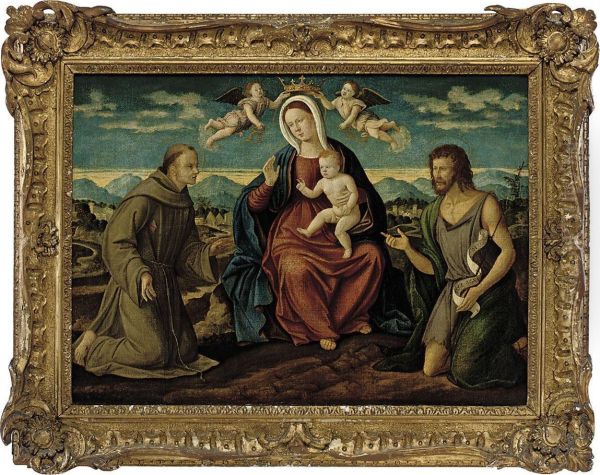Girolamo da Santacroce stands as a notable figure in the vibrant artistic landscape of sixteenth-century Venice. Active during a period of immense creative output and innovation, he carved out a niche for himself, contributing to the rich tapestry of the Venetian School. While perhaps not as universally renowned as some of his towering contemporaries, Santacroce's oeuvre reflects the prevailing artistic currents of his time, particularly the enduring influence of the Bellini workshop and the burgeoning High Renaissance style. His life, spanning from approximately 1480-1485 to his death in 1556, saw him navigate the complex world of patronage, workshop production, and artistic evolution in one of Europe's most dynamic cultural centers.
Early Life and Artistic Formation
Born in the small town of Santa Croce, near Bergamo, which likely gave him his cognomen "da Santacroce," Girolamo Rizzi (his family name) moved to Venice, the bustling maritime republic that was a magnet for artists and craftsmen. The precise details of his earliest training are somewhat debated by scholars, but it is widely accepted that he became associated with the preeminent Bellini family workshop. Some sources suggest an initial apprenticeship under Gentile Bellini (c. 1429–1507), possibly entering his studio around 1503. Gentile was renowned for his large-scale narrative paintings and his meticulous detail, qualities that would have provided a solid foundation for any aspiring artist.
Following Gentile's death in 1507, Girolamo's connection to the Bellini legacy likely continued, and perhaps intensified, through Giovanni Bellini (c. 1430–1516), Gentile's brother and arguably the most influential Venetian painter of his generation. Giovanni's workshop was a powerhouse, training and influencing a host of artists who would go on to define Venetian painting. Girolamo is often described as a pupil or assistant in Giovanni Bellini's studio, absorbing the master's late style characterized by harmonious compositions, luminous color, atmospheric landscapes, and a gentle, humanized approach to religious subjects. It's plausible he remained connected to the Bellini workshop until Giovanni's death, or even established his independent practice while still heavily drawing upon Bellini's models.

Further enriching his artistic vocabulary, Girolamo da Santacroce may have also spent time in the workshop of Cima da Conegliano (c. 1459–c. 1517). Cima, another prominent Venetian painter, was known for his serene landscapes and clear, bright palette, often echoing Bellini's style but with his own distinct sensibility. This period of multifaceted training exposed Santacroce to various facets of Venetian artistic practice, equipping him with the skills to cater to a diverse clientele.
The Venetian Artistic Milieu in the Early Sixteenth Century
To understand Girolamo da Santacroce's career, it's crucial to appreciate the artistic environment of Venice in the early 1500s. The city was at a cultural zenith. The Bellini workshop had laid a strong foundation, but a new generation was emerging, pushing artistic boundaries. Giorgione (c. 1477/8–1510), though his career was tragically short, introduced a new poetic and enigmatic quality to painting, emphasizing mood and atmosphere, often in secular, pastoral scenes. His influence was profound and pervasive.
Simultaneously, a young Titian (Tiziano Vecellio, c. 1488/1490–1576) was beginning his meteoric rise. Initially influenced by Giorgione and Bellini, Titian would soon develop a dynamic, robust style characterized by rich color, dramatic compositions, and psychological depth, becoming the dominant figure in Venetian art for decades. Palma Vecchio (Jacopo Negretti, c. 1480–1528), a contemporary of Santacroce, was also making his mark with sensuous depictions of Madonnas, saints, and mythological figures, often set within idyllic landscapes. His work was celebrated for its rich textures and warm, glowing colors.
Other significant artists active during Santacroce's formative years and early career included Vittore Carpaccio (c. 1460–1526), known for his detailed narrative cycles depicting Venetian life and religious stories, and Sebastiano del Piombo (c. 1485–1547), who began his career in Venice under Bellini and Giorgione before moving to Rome. Lorenzo Lotto (c. 1480–1556/57), another Bellini-influenced artist, developed a highly individualistic style characterized by psychological intensity and unconventional compositions. These artists, among many others like Vincenzo Catena and Marco Basaiti, contributed to a competitive yet stimulating environment where different styles and approaches coexisted and intermingled.
Artistic Style and Dominant Influences
Girolamo da Santacroce's artistic style is deeply rooted in the Venetian tradition, particularly the late works of Giovanni Bellini. This Bellinesque foundation is evident in his preference for balanced, often symmetrical compositions, the gentle and contemplative expressions of his figures, and the inclusion of serene, atmospheric landscapes that recede into the distance. His color palette, while rich, often retains a clarity and luminosity reminiscent of Bellini and Cima. He demonstrated a consistent concern for detail, rendering drapery, foliage, and architectural elements with care.

The influence of Titian and Palma Vecchio can also be discerned in Santacroce's work, particularly as his career progressed. From Titian, he may have absorbed a greater sense of dynamism in certain figures or a richer application of paint, though he rarely achieved Titian's dramatic intensity. Palma Vecchio's influence might be seen in the softer modeling of figures and the warm tonalities that appear in some of Santacroce's paintings. However, it's important to note that Santacroce's engagement with these more progressive styles was often tempered by a fundamentally conservative approach.
A significant aspect of Santacroce's practice was his production of copies and variations of works by more famous masters, including Bellini, Cima, Titian, and Palma Vecchio. This was a common practice in the Renaissance, catering to a market of patrons who desired works in the style of renowned artists but perhaps could not afford originals or sought specific compositions. While this sometimes leads to his characterization as a "working-type painter" or an eclectic artist, it also demonstrates his technical skill and his ability to adapt to prevailing tastes. Many of his works bear his signature and often a date, which has been invaluable for art historians in reconstructing his career.
Key Works and Thematic Concerns
Girolamo da Santacroce was a prolific painter, and his output primarily consisted of religious subjects, which were in high demand for churches, private chapels, and devotional use. His repertoire included altarpieces, smaller panels for private devotion, and narrative scenes.
One of his early dated works is the Letherthe Madonna and Child of 1516, now in the Art Institute of Chicago. This painting clearly shows his Bellinesque training in the tender interaction between the Virgin and Child and the characteristic landscape background. The composition is harmonious, and the figures possess a quiet dignity.
Another notable work often attributed to him or his workshop is The Annunciation, which exists in several versions, showcasing his ability to adapt popular compositions. These typically feature the Archangel Gabriel approaching the Virgin Mary in a carefully rendered architectural setting, often with a landscape visible through a window or opening, a hallmark of Venetian painting.
His Saint John the Baptist, praised for its precise anatomical rendering and vivid coloration, demonstrates his skill in depicting solitary figures with a sense of gravitas. The saint is often shown in a wilderness setting, a theme that allowed for the inclusion of detailed landscape elements. Similarly, his Young Saint Reading captures a moment of quiet contemplation, with soft tonalities and a focus on the introspective mood of the figure, again echoing the Bellinesque tradition of depicting saints in moments of serene devotion.

Santacroce also produced multi-panel altarpieces, or polyptychs. An example like Saint with a Fortress and a Banner (likely part of a larger ensemble) would have featured saints flanking a central panel, often a Madonna and Child or a scene from the life of Christ. These works demonstrate his ability to organize complex compositions and maintain a consistent stylistic and thematic coherence across multiple panels. The depiction of saints often included their traditional attributes, making them easily identifiable to the faithful.
A significant later work is The Last Supper, a fresco painted in 1549 for the church of San Martino in Venice (now in San Francesco della Vigna). This large-scale commission indicates his established reputation in the city. Fresco painting was less common in Venice than oil on canvas due to the city's humidity, so this work is particularly noteworthy. It demonstrates his capacity to handle monumental compositions and adapt his style to the demands of wall painting.
Throughout his career, Santacroce frequently depicted the Madonna and Child, a staple of Venetian art. These works vary in complexity, from simple half-length figures to more elaborate Sacre Conversazioni (holy conversations), where the Virgin and Child are accompanied by saints. These paintings often emphasize the tender, human relationship between mother and child, a characteristic he inherited from Bellini.
The Workshop and Artistic Practice
Like most successful artists of his time, Girolamo da Santacroce likely maintained an active workshop. This workshop would have assisted him in producing the numerous paintings commissioned from him, including replicas and variations of popular compositions. The involvement of assistants was standard practice and allowed for a higher volume of output. This also explains some of the variations in quality and style that can be observed across the body of work attributed to him and his circle. His son, Francesco di Girolamo da Santacroce, also became a painter and continued the workshop tradition, sometimes collaborating with his father.
The practice of signing and dating works, which Girolamo frequently did, was a way of branding his output and asserting his authorship, even for compositions that were heavily indebted to other masters. This suggests a savvy understanding of the art market. His clients were likely a mix of ecclesiastical patrons, confraternities, and private individuals who appreciated his competent and reliable adherence to established Venetian artistic conventions.

His reputation as a "working painter" who often replicated successful formulas should not entirely overshadow his own artistic merits. He was a skilled craftsman with a fine sense of color and composition. His works, while perhaps not groundbreaking in terms of innovation, provided patrons with aesthetically pleasing and devotionally effective images that were well within the mainstream of Venetian taste. He successfully navigated a competitive art world by offering a dependable product that met the demands of a broad clientele.
Contemporaries: A Web of Influence, Collaboration, and Competition
The Venetian art scene was a tightly knit community where artists were acutely aware of each other's work. Santacroce's career unfolded alongside some of the giants of the Renaissance. While direct collaborative documents with artists like Titian or Palma Vecchio are scarce, their stylistic influence on him is undeniable, suggesting he studied their works closely. He was part of a broader group of painters, sometimes referred to as "Belliniani," who continued Giovanni Bellini's legacy well into the sixteenth century. This group included artists like Andrea Previtali and Vincenzo Catena, who, like Santacroce, adapted Bellini's style while also responding to newer trends.
The competitive aspect of the Venetian art market meant that artists often vied for the same commissions. Santacroce's strategy of producing reliable, Bellini-esque works, sometimes incorporating elements from more fashionable painters like Titian or Palma, allowed him to carve out a sustainable career. He wasn't necessarily competing at the very highest echelons with Titian for major state commissions, but he found a steady demand for his religious paintings.
His relationship with other artists from Bergamo or the Bergamasque region who were active in Venice, such as Palma Vecchio and Andrea Previtali, might also have been significant. Regional networks often played a role in workshop connections and patronage. Furthermore, the presence of artists like Bonifacio Veronese (Bonifacio de' Pitati), who was heavily influenced by Palma Vecchio and Titian, and Paris Bordone, a student of Titian, further illustrates the dynamic interplay of influences that characterized Venetian painting during Santacroce's lifetime. Even younger masters who would later dominate the scene, such as Jacopo Tintoretto and Paolo Veronese, were beginning their careers towards the end of Santacroce's life, heralding a shift towards Mannerism and the grand decorative schemes of the later sixteenth century.
Later Career, Legacy, and Distinctions

Girolamo da Santacroce remained active as a painter until his death in Venice on July 9, 1556. His later works generally continue in the vein established earlier in his career, though some may show a greater assimilation of High Renaissance ideals of monumentality and grace, filtered through his characteristically conservative lens. He maintained a consistent output, fulfilling commissions and contributing to the visual culture of Venice and its territories.
His legacy is that of a competent and prolific master who played a role in disseminating the Venetian style, particularly the Bellinesque tradition, to a wider audience. While he may not have been an innovator on the scale of Titian or Giorgione, his work is representative of a significant stratum of artistic production in Renaissance Venice. His paintings are found in numerous churches and museums across Europe and North America, attesting to his productivity and the appeal of his art.
It is crucial to distinguish Girolamo da Santacroce the painter from another artist of a similar name, Girolamo Santacroce (c. 1502–c. 1537), who was a sculptor and architect active primarily in Naples. This Neapolitan Girolamo Santacroce was a significant figure in the Renaissance sculpture of Southern Italy, and the similarity in names can sometimes lead to confusion, but their artistic media, geographical focus, and stylistic concerns were entirely different.
Historical Assessment and Art Historical Position
In the grand narrative of art history, Girolamo da Santacroce is often positioned as a secondary master, a follower rather than a leader. This assessment, while having some validity when compared to the towering geniuses of his era, should not diminish his genuine contributions. He was a skilled practitioner of the Venetian school, proficient in its techniques of color and light, and adept at creating compositions that were both aesthetically pleasing and spiritually resonant for his contemporary audience.
His adherence to the models of Giovanni Bellini, even decades after Bellini's death, speaks to the enduring power and appeal of that master's style. At the same time, his willingness to incorporate elements from Titian, Palma Vecchio, and others demonstrates an awareness of evolving tastes. His art can be seen as a bridge, in some ways, between the Early Renaissance sensibilities of Bellini and the High Renaissance developments.
Art historians value Santacroce's work for several reasons. His signed and dated paintings provide important chronological markers and help to understand workshop practices. His oeuvre illustrates the breadth and depth of artistic production in Venice, showing that the art scene was not solely defined by its most famous names. He represents the skilled and reliable artists who catered to a substantial portion of the art market, fulfilling the devotional and decorative needs of a wide range of patrons. His paintings offer a window into the conventional religious iconography and artistic tastes of sixteenth-century Venice.
While some critics have pointed to a certain conservatism or lack of dynamism in his work compared to the more innovative trends of his time, this can also be interpreted as a deliberate choice to cater to patrons who favored more traditional, Bellini-esque compositions. His art provided a sense of continuity and familiarity in a rapidly changing world.
Conclusion
Girolamo da Santacroce was a significant and productive painter of the Venetian Renaissance whose career spanned a period of extraordinary artistic ferment. Trained in the esteemed Bellini workshop and influenced by contemporaries like Cima da Conegliano, Titian, and Palma Vecchio, he developed a style that, while rooted in tradition, was responsive to the evolving artistic landscape. His prolific output of religious paintings, characterized by harmonious compositions, rich Venetian color, and a gentle devotional quality, found favor with a wide range of patrons.
Though perhaps overshadowed by some of the more revolutionary figures of his time, Santacroce played a vital role in the Venetian art world. He was a master craftsman who, through his workshop and his numerous signed works, contributed to the dissemination of the Venetian style and catered to the consistent demand for religious imagery. His paintings, found in collections worldwide, continue to be appreciated for their technical skill, their embodiment of Venetian artistic conventions, and their quiet, enduring appeal, securing his place as a noteworthy, if not leading, master of his era. His life and work offer valuable insights into the artistic practices, patronage systems, and aesthetic preferences of sixteenth-century Venice.